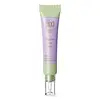What's inside
What's inside
 Key Ingredients
Key Ingredients

 Benefits
Benefits

 Concerns
Concerns

 Ingredients Side-by-side
Ingredients Side-by-side

Water
Skin ConditioningGlycerin
HumectantAlcohol Denat.
AntimicrobialDimethicone
EmollientCaffeine
Skin ConditioningAcrylates/C10-30 Alkyl Acrylate Crosspolymer
Emulsion StabilisingAscorbyl Glucoside
AntioxidantCaprylyl Glycol
EmollientCarbomer
Emulsion StabilisingCI 77891
Cosmetic ColorantDimethiconol
EmollientEscin
TonicMentha Piperita Extract
CleansingMica
Cosmetic ColorantPEG/PPG-18/18 Dimethicone
EmulsifyingPhenoxyethanol
PreservativeSalicylic Acid
MaskingSodium Hydroxide
BufferingXanthan Gum
EmulsifyingFish Oil
Skin ConditioningCeramide AP
Skin ConditioningWater, Glycerin, Alcohol Denat., Dimethicone, Caffeine, Acrylates/C10-30 Alkyl Acrylate Crosspolymer, Ascorbyl Glucoside, Caprylyl Glycol, Carbomer, CI 77891, Dimethiconol, Escin, Mentha Piperita Extract, Mica, PEG/PPG-18/18 Dimethicone, Phenoxyethanol, Salicylic Acid, Sodium Hydroxide, Xanthan Gum, Fish Oil, Ceramide AP
Water
Skin ConditioningPersea Gratissima Oil
Skin ConditioningGlycerin
HumectantCetearyl Alcohol
EmollientPotassium Cetyl Phosphate
EmulsifyingButyrospermum Parkii Butter
Skin ConditioningSimmondsia Chinensis Seed Oil
EmollientSqualane
EmollientHydroxyethyl Acrylate/Sodium Acryloyldimethyl Taurate Copolymer
Emulsion StabilisingPanthenol
Skin ConditioningRetinol
Skin ConditioningSambucus Nigra Flower Extract
RefreshingVaccinium Angustifolium Fruit Extract
Skin ProtectingHelianthus Annuus Seed Oil
EmollientGlycyrrhiza Glabra Root Extract
BleachingHydrolyzed Collagen
EmollientTocopherol
AntioxidantAdenosine
Skin ConditioningSodium Hyaluronate
HumectantC12-15 Alkyl Benzoate
AntimicrobialSorbitan Laurate
EmulsifyingC18-36 Acid Glycol Ester
EmollientC18-36 Acid Triglyceride
EmollientPalmitoyl Tripeptide-1
Skin ConditioningPalmitoyl Tetrapeptide-7
Skin ConditioningCaffeine
Skin ConditioningXanthan Gum
EmulsifyingDisodium EDTA
Polysorbate 60
EmulsifyingPhenoxyethanol
PreservativeEthylhexylglycerin
Skin ConditioningLaureth-23
CleansingBHT
AntioxidantBHA
AntioxidantWater, Persea Gratissima Oil, Glycerin, Cetearyl Alcohol, Potassium Cetyl Phosphate, Butyrospermum Parkii Butter, Simmondsia Chinensis Seed Oil, Squalane, Hydroxyethyl Acrylate/Sodium Acryloyldimethyl Taurate Copolymer, Panthenol, Retinol, Sambucus Nigra Flower Extract, Vaccinium Angustifolium Fruit Extract, Helianthus Annuus Seed Oil, Glycyrrhiza Glabra Root Extract, Hydrolyzed Collagen, Tocopherol, Adenosine, Sodium Hyaluronate, C12-15 Alkyl Benzoate, Sorbitan Laurate, C18-36 Acid Glycol Ester, C18-36 Acid Triglyceride, Palmitoyl Tripeptide-1, Palmitoyl Tetrapeptide-7, Caffeine, Xanthan Gum, Disodium EDTA, Polysorbate 60, Phenoxyethanol, Ethylhexylglycerin, Laureth-23, BHT, BHA
Ingredients Explained
These ingredients are found in both products.
Ingredients higher up in an ingredient list are typically present in a larger amount.
Caffeine is most associated with coffee, tea, and cacao. In skincare, it helps with calming inflammation and is rich in antioxidants.
While caffeine is used to treat cellulite and and dark circles, further studies are needed to prove this. It has been believed to help with these skin conditions due to its ability to dilate blood vessels and increase blood flow.
Some studies are looking into caffeine's ability to protect against UV rays.
Learn more about CaffeineGlycerin is already naturally found in your skin. It helps moisturize and protect your skin.
A study from 2016 found glycerin to be more effective as a humectant than AHAs and hyaluronic acid.
As a humectant, it helps the skin stay hydrated by pulling moisture to your skin. The low molecular weight of glycerin allows it to pull moisture into the deeper layers of your skin.
Hydrated skin improves your skin barrier; Your skin barrier helps protect against irritants and bacteria.
Glycerin has also been found to have antimicrobial and antiviral properties. Due to these properties, glycerin is often used in wound and burn treatments.
In cosmetics, glycerin is usually derived from plants such as soybean or palm. However, it can also be sourced from animals, such as tallow or animal fat.
This ingredient is organic, colorless, odorless, and non-toxic.
Glycerin is the name for this ingredient in American English. British English uses Glycerol/Glycerine.
Learn more about GlycerinPhenoxyethanol is a preservative that has germicide, antimicrobial, and aromatic properties. Studies show that phenoxyethanol can prevent microbial growth. By itself, it has a scent that is similar to that of a rose.
It's often used in formulations along with Caprylyl Glycol to preserve the shelf life of products.
Water. It's the most common cosmetic ingredient of all. You'll usually see it at the top of ingredient lists, meaning that it makes up the largest part of the product.
So why is it so popular? Water most often acts as a solvent - this means that it helps dissolve other ingredients into the formulation.
You'll also recognize water as that liquid we all need to stay alive. If you see this, drink a glass of water. Stay hydrated!
Learn more about WaterXanthan gum is used as a stabilizer and thickener within cosmetic products. It helps give products a sticky, thick feeling - preventing them from being too runny.
On the technical side of things, xanthan gum is a polysaccharide - a combination consisting of multiple sugar molecules bonded together.
Xanthan gum is a pretty common and great ingredient. It is a natural, non-toxic, non-irritating ingredient that is also commonly used in food products.
Learn more about Xanthan Gum